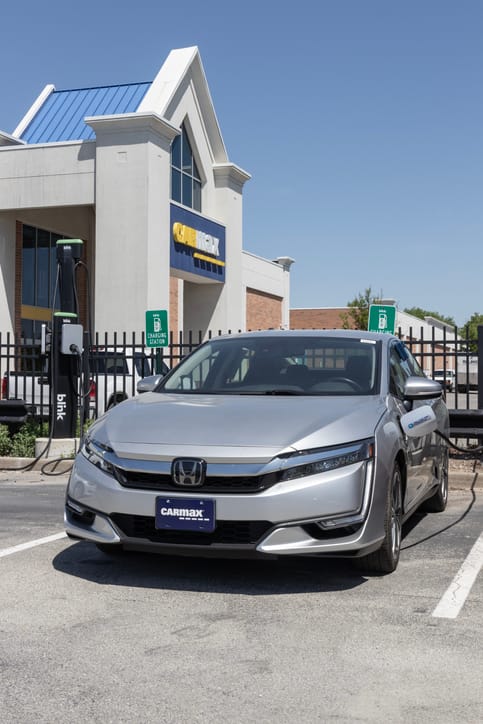The Honda Clarity: A Look Back at an Eco-Friendly Pioneer

The Honda Clarity wasn't your average sedan. It was a bold experiment from Honda, a three-pronged attack on reducing emissions that offered a glimpse into the future of automobiles. Launched in 2016, the Clarity boasted a unique distinction: it was available in not one, but two alternative fuel variants – the Clarity Plug-in Hybrid and the Clarity Fuel Cell Vehicle (FCV).
While production ended in August 2021, the Clarity's legacy lives on. This article explores the different iterations of the Clarity, its features, and the reasons behind Honda's decision to discontinue the model.
A Trio of Eco-Conscious Choices
The Clarity lineup consisted of three distinct powertrains:
- Clarity Fuel Cell Vehicle (FCV): This futuristic version used hydrogen fuel to generate electricity. By combining hydrogen with oxygen from the air, the FCV produced nothing but water vapor as a byproduct, making it a true zero-emission vehicle.
- Clarity Plug-in Hybrid (PHEV): This variant offered the best of both worlds. It packed a gasoline engine and an electric motor, allowing drivers to switch between electric power for shorter commutes and gasoline for longer trips. The PHEV also came with a plug-in battery that could be charged externally, extending the electric driving range.
- Battery Electric Vehicle (BEV): Though not officially available in the United States, Honda offered a limited run of Clarity EVs in certain international markets.
Each variant was distinguished by a unique "hero color" and subtle design differences on the front grille, headlights, and taillights.
A Closer Look at the Clarity's Offerings
1. Clarity Fuel Cell Vehicle (FCV):
The FCV was a technological marvel. Refueling with hydrogen took around five minutes, similar to a gasoline car. Additionally, the FCV offered an impressive driving range, exceeding 300 miles on a single fill-up.
However, the FCV's biggest drawback was limited hydrogen station infrastructure. While hydrogen fuel cell technology held great promise, the lack of readily available refueling stations made the FCV impractical for many drivers.
2. Clarity Plug-in Hybrid (PHEV):
The PHEV addressed the range anxiety often associated with electric vehicles. It boasted an electric driving range of around 80 miles, perfect for everyday errands. When the battery depleted, the gasoline engine seamlessly kicked in, ensuring extended travel without needing to stop for a charge.
The PHEV also offered a spacious and comfortable interior with seating for five adults. Honda packed the Clarity with their suite of advanced safety features, making it a compelling choice for eco-conscious families.
3. Clarity Battery Electric Vehicle (BEV):
The BEV variant, although not available in the US market, showcased Honda's commitment to exploring various electric vehicle technologies. It offered a glimpse into the future direction of the brand.
Why Did Honda Discontinue the Clarity?
Despite its innovative features, the Clarity fell short of achieving mainstream success. Here are some possible reasons behind Honda's decision to end production:
- Limited Hydrogen Infrastructure: The FCV's reliance on hydrogen refueling stations significantly restricted its appeal. Building a widespread hydrogen infrastructure requires significant investment, and the technology is still in its early stages of development.
- Competition in the PHEV Market: The Clarity PHEV faced stiff competition from established players like Toyota Prius Prime and newer entrants like the Hyundai Sonata PHEV. While the Clarity offered a good electric range and a comfortable cabin, it may not have stood out enough in a crowded marketplace.
- Shifting Focus to Battery Electric Vehicles (BEVs): With increasing consumer interest in BEVs and government incentives encouraging electric vehicle adoption, Honda might be strategically shifting its focus towards developing fully electric vehicles.
The Clarity's Legacy
The Honda Clarity may not have become a runaway success story, but it served a critical purpose. It was a stepping stone, a testament to Honda's commitment to exploring alternative fuel technologies and paving the way for a cleaner future. The lessons learned from the Clarity will undeniably influence Honda's future electric vehicle development.
Here are some key takeaways from the Clarity's journey:
- The importance of infrastructure: For alternative fuel vehicles to gain traction, a robust network of refueling or charging stations is essential.
- Consumer adoption: Consumers need to be convinced of the practicality and affordability of new technologies before widespread adoption can occur.
- Continuous innovation: The automotive industry is constantly evolving. The Clarity serves as a reminder of the ongoing commitment to developing cleaner and more sustainable transportation solutions.
The Honda Clarity might be gone, but its legacy lives on. It serves as a reminder of the ongoing quest for sustainable transportation and the continuous innovation driving the automotive industry towards a greener future.
